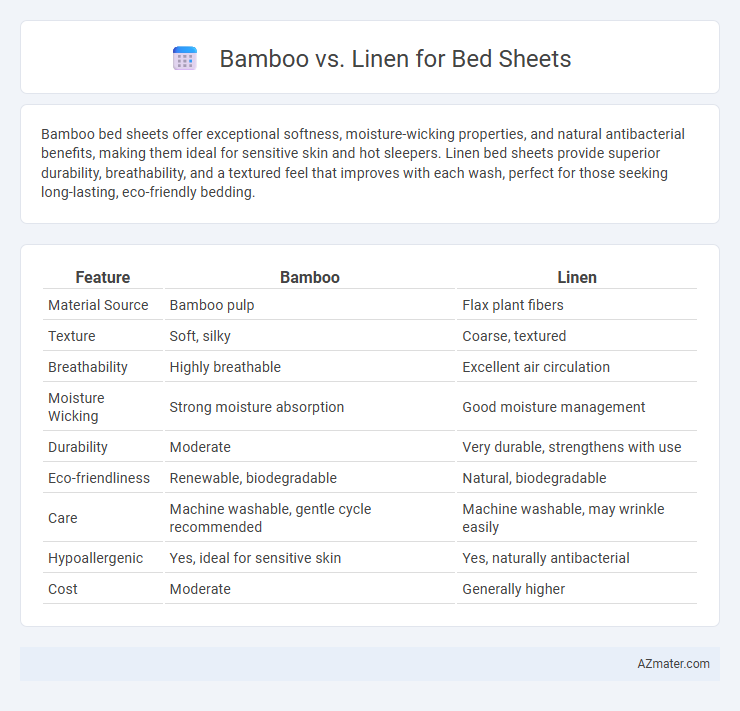Bamboo bed sheets offer exceptional softness, moisture-wicking properties, and natural antibacterial benefits, making them ideal for sensitive skin and hot sleepers. Linen bed sheets provide superior durability, breathability, and a textured feel that improves with each wash, perfect for those seeking long-lasting, eco-friendly bedding.
Table of Comparison
| Feature | Bamboo | Linen |
|---|---|---|
| Material Source | Bamboo pulp | Flax plant fibers |
| Texture | Soft, silky | Coarse, textured |
| Breathability | Highly breathable | Excellent air circulation |
| Moisture Wicking | Strong moisture absorption | Good moisture management |
| Durability | Moderate | Very durable, strengthens with use |
| Eco-friendliness | Renewable, biodegradable | Natural, biodegradable |
| Care | Machine washable, gentle cycle recommended | Machine washable, may wrinkle easily |
| Hypoallergenic | Yes, ideal for sensitive skin | Yes, naturally antibacterial |
| Cost | Moderate | Generally higher |
Introduction to Bamboo and Linen Bed Sheets
Bamboo bed sheets are crafted from bamboo fibers, offering exceptional softness, breathability, and natural moisture-wicking properties, making them ideal for hot sleepers. Linen bed sheets, made from flax fibers, boast superior durability, a unique textured feel, and excellent temperature regulation suited for both warm and cool climates. Both bamboo and linen sheets provide eco-friendly options, with bamboo growing rapidly and linen requiring minimal pesticides, appealing to environmentally conscious consumers.
Material Origins: Bamboo vs Linen
Bamboo bed sheets are made from the fibers of the bamboo plant, a fast-growing, renewable resource known for its natural antibacterial and moisture-wicking properties. Linen bed sheets originate from the flax plant, cultivated for thousands of years, producing strong, breathable fabric prized for durability and temperature regulation. Both materials offer eco-friendly benefits, but bamboo's rapid growth and minimal water requirements often make it a more sustainable choice compared to the traditional but resource-intensive flax cultivation.
Environmental Impact and Sustainability
Bamboo bed sheets are highly sustainable due to the rapid growth and low water requirements of bamboo plants, along with their natural pest resistance that reduces the need for harmful pesticides. Linen, derived from flax plants, also offers an eco-friendly option as it requires minimal water and pesticides, plus its fibers are biodegradable and durable, leading to less frequent replacements. Both materials provide strong environmental benefits, but bamboo typically has a lower carbon footprint and faster renewability, making it a preferred choice for eco-conscious consumers.
Comfort and Feel: Softness and Texture Comparison
Bamboo bed sheets offer exceptional softness due to their natural microfibers, creating a smooth, silky texture that feels gentle against the skin, ideal for sensitive sleepers. Linen sheets exhibit a more textured, breathable fabric that softens over time while providing a crisp, cool feel, perfect for warmer climates. Both materials excel in comfort, with bamboo prioritizing silky softness and linen delivering a durable, airy texture.
Breathability and Temperature Regulation
Bamboo bed sheets excel in breathability due to their moisture-wicking properties, allowing air to flow freely and keeping sleepers cool. Linen sheets naturally regulate temperature by absorbing and releasing moisture quickly, making them ideal for both hot and cool climates. Both fabrics enhance sleep comfort through superior ventilation, but bamboo offers a softer feel while linen provides increased durability.
Durability and Longevity of Bamboo and Linen Sheets
Bamboo bed sheets offer impressive durability due to their natural fibers, which resist wear and tear while maintaining softness after multiple washes. Linen sheets are renowned for their exceptional longevity, often lasting decades because flax fibers strengthen over time and become softer with use. Both materials provide robust, long-lasting bedding options, but linen typically outperforms bamboo in terms of extended durability and lifespan.
Maintenance: Care and Washing Instructions
Bamboo bed sheets require gentle washing in cold water using a mild detergent to maintain their softness and durability, and they should be air-dried or tumble-dried on low heat to prevent shrinking. Linen sheets need washing in warm water with a mild detergent, and they tend to become softer with each wash, but high heat drying is discouraged to avoid damage. Both materials benefit from avoiding bleach and fabric softeners to preserve their natural fibers and extend their lifespan.
Hypoallergenic and Skin-Friendly Properties
Bamboo bed sheets offer superior hypoallergenic properties due to their natural antimicrobial and moisture-wicking fibers, making them ideal for sensitive skin and allergy sufferers. Linen sheets, while breathable and moisture-absorbent, may cause irritation for individuals with very sensitive skin because of their coarser texture compared to bamboo. Both fabrics promote skin-friendly benefits, but bamboo's softness and resistance to dust mites provide a more reliable option for hypoallergenic bedding.
Price Comparison and Value for Money
Bamboo bed sheets typically range from $30 to $80, offering durability, moisture-wicking, and hypoallergenic properties that justify their slightly higher price. Linen sheets usually cost between $40 and $100, prized for breathability, natural texture, and long-term resilience, which enhances their value despite the premium. Choosing between bamboo and linen depends on budget constraints and desired fabric benefits, with bamboo offering a softer feel at a lower cost and linen providing robust longevity and cooling comfort.
Which Should You Choose: Bamboo or Linen Bed Sheets?
Bamboo bed sheets offer exceptional softness, moisture-wicking properties, and natural antibacterial benefits, making them ideal for hot sleepers and sensitive skin. Linen sheets, crafted from flax fibers, provide superior durability, breathability, and a unique textured feel that softens with each wash, perfect for those seeking a natural, eco-friendly option with long-lasting comfort. Choose bamboo for silky smoothness and temperature regulation or linen for rugged strength and a cool, airy sleep environment.

Infographic: Bamboo vs Linen for Bed Sheet
 azmater.com
azmater.com